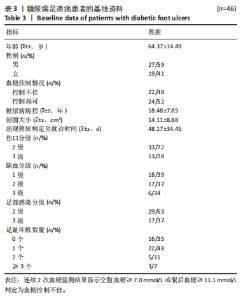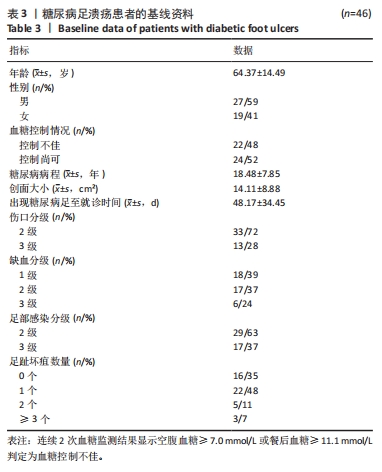Chinese Journal of Tissue Engineering Research ›› 2024, Vol. 28 ›› Issue (29): 4599-4604.doi: 10.12307/2024.570
Previous Articles Next Articles
Antibiotic-loaded bone cement enhances ability of tibial cortex transverse transport for treating infected wounds
Liu Junpeng1, Yao Xingchen1, Zhao Hui1, Xu Ziyu1, Wu Yue1, Pei Fuchun2, Zhang Lin2, Du Xinru1
- 1Department of Orthopedic Surgery, Beijing Chaoyang Hospital, Capital Medical University, Beijing 100027, China; 2Beijing Chaoyang Integrative Medicine Rescue and First Aid Hospital, Beijing 100022, China
-
Received:2023-11-06Accepted:2023-12-02Online:2024-10-18Published:2024-03-22 -
Contact:Du Xinru, MD, Chief physician, Professor, Doctoral supervisor, Department of Orthopedic Surgery, Beijing Chaoyang Hospital, Capital Medical University, Beijing 100027, China -
About author:Liu Junpeng, Master, Department of Orthopedic Surgery, Beijing Chaoyang Hospital, Capital Medical University, Beijing 100027, China
CLC Number:
Cite this article
Liu Junpeng, Yao Xingchen, Zhao Hui, Xu Ziyu, Wu Yue, Pei Fuchun, Zhang Lin, Du Xinru. Antibiotic-loaded bone cement enhances ability of tibial cortex transverse transport for treating infected wounds[J]. Chinese Journal of Tissue Engineering Research, 2024, 28(29): 4599-4604.
share this article
Add to citation manager EndNote|Reference Manager|ProCite|BibTeX|RefWorks
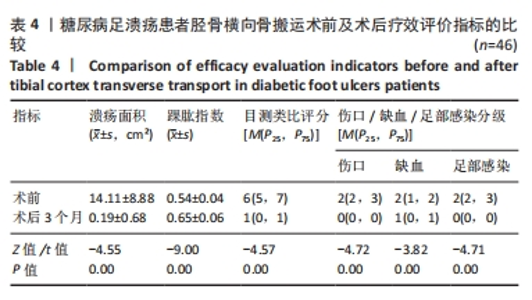
46例患者中,男27例,女19例;年龄38-91岁,平均64.37岁;糖尿病病程2-34年,平均18.48年;从此次出现足部溃疡到就诊的时间为18-93 d,平均48.17 d;溃疡创面大小2-34 cm2,平均14.11 cm2;22例患者住院期间至少连续2次血糖监测结果显示空腹血糖≥7.0 mmol/L或餐后血糖≥11.1 mmol/L判定为血糖控制不佳;16例患者入院时无足趾坏疽,22例患者有1根足趾出现坏疽,5例患者有2根足趾坏疽,3例患者有3根或3根以上的足趾出现坏疽。研究期间,对12例患者的15根足趾进行了截趾手术,截趾创面均正常愈合。 2.3 糖尿病足溃疡患者手术参数 平均手术时间为(58.84±8.73) min,平均出血量为(51.32±7.11) mL,平均透视次数为(7.64±1.44)次。1例手术过程中发生钻头断裂,找到钻头,未导致术后并发症。 2.4 糖尿病足溃疡患者治疗后的临床疗效及并发症 溃疡愈合时间为21-104 d,平均58.07 d。 经Kolmogorov-Smirnov检验,胫骨横向骨搬运术前及术后3个月的踝肱指数符合正态分布规律,使用配对样本t检验进行统计学分析。术前溃疡面积呈正态分布,术后溃疡面积呈偏态分布,采用Wilcoxon秩和检验进行统计学分析。目测类比评分及WIFi分级属于等级资料,采用Wilcoxon秩和检验。统计分析结果表明,同胫骨横向骨搬运术前相比,患者胫骨横向骨搬运术后3个月的溃疡面积、踝肱指数、目测类比评分及WIFi分级均得到显著改善(P < 0.05),平均踝肱指数由术前的0.54±0.04提升为术后的0.65±0.06,中位目测类比评分由6分降为1分,平均溃疡面积由(14.11±8.88) cm2缩小为(0.19±0.68) cm2,见表4。"
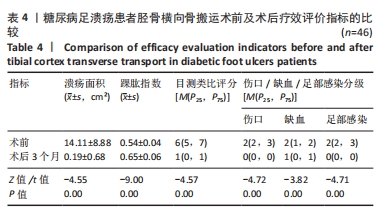
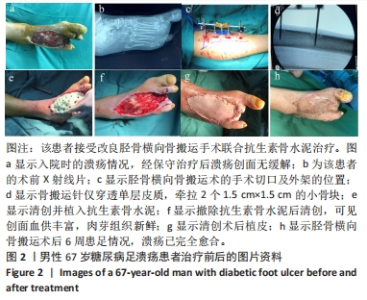
43例患者的溃疡完全愈合,溃疡愈合率为93%(43/46),随访期间无溃疡或感染复发;3例患者的溃疡未在随访期内愈合,但溃疡面积较术前明显缩小并于后续追踪随访中完全愈合。 术后2例患者发生钉道感染,在对钉道进行乙醇消毒及专业护理后感染得到控制,其余44例患者未出现需要处理的并发症,并发症发生率为4%(2/46)。 2.5 典型病例 1名67岁男性患者,因“右足第二足趾破溃,足背大面积溃疡1个月余”入首都医科大学附属北京朝阳医院接受治疗。既往高血压、反流性食管炎病史。24年前诊断为1型糖尿病,血糖控制不佳。半年前因右足三、四足趾坏疽行截趾术。术前溃疡面积约30 cm2,于外院行敷药、清创等传统治疗无效,入院时溃疡创面暗紫色(图2a)。入院后拍摄X射线片,排除深部感染(图2b)。待术前检查完善后行胫骨横向骨搬运术(图2c、d),同期行扩创+抗生素骨水泥植入术(图2e)。此后每间隔4 d行清创术并更换抗生素骨水泥(图2f),期间行第二足趾截趾,累计4次清创术后观察到创面血供丰富,肉芽新鲜,行植皮术(图2g)。胫骨横向骨搬运术后5周拆除外固定架,此时创面基本愈合,外架拆除1周后创面完全愈合(图2h)。术后3个月随访期结束时,该患者的目测类比评分由术前6分降至1分,踝肱指数由术前的0.51升至术后的0.69。随访期间该患者没有出现溃疡或感染复发。"
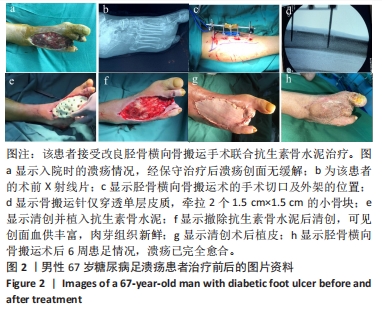
| [1] SUN H, SAEEDI P, KARURANGA S, et al. IDF Diabetes Atlas: Global, regional and country-level diabetes prevalence estimates for 2021 and projections for 2045. Diabetes Res Clin Pr. 2022;183:109119. [2] ARMSTRONG DG, BOULTON AJM, BUS SA. Diabetic Foot Ulcers and Their Recurrence. N Engl J Med. 2017;376(24):2367-2375. [3] GUO J, BAO H, LIDEER, et al. Efficacy and safety of tibial cortex transverse transport for diabetic foot: A protocol for systematic review and meta-analysis. PLoS One. 2022;17(11):e277269. [4] HINCHLIFFE RJ, BROWNRIGG JRW, ANDROS G, et al. Effectiveness of revascularization of the ulcerated foot in patients with diabetes and peripheral artery disease: a systematic review. Diabetes Metab Res Rev. 2016;32 Suppl 1: 136-144. [5] IRAWAN H, SEMADI IN, WIDIANA IGR. A Pilot Study of Short-Duration Hyperbaric Oxygen Therapy to Improve HbA1c, Leukocyte, and Serum Creatinine in Patients with Diabetic Foot Ulcer Wagner 3-4. Sci World J. 2018;2018:1-6. [6] ALAVI A, SIBBALD RG, MAYER D, et al. Diabetic foot ulcers: Part I. Pathophysiology and prevention. J Am Acad Dermatol. 2014;70(1):19-20. [7] GREENMAN RL, PANASYUK S, WANG X, et al. Early changes in the skin microcirculation and muscle metabolism of the diabetic foot. Lancet. 2005; 366(9498):1711-1717. [8] EHYA REM, ZHANG H, QI B, et al. Application and Clinical Effectiveness of Antibiotic-Loaded Bone Cement to Promote Soft Tissue Granulation in the Treatment of Neuropathic Diabetic Foot Ulcers Complicated by Osteomyelitis: A Randomized Controlled Trial. J Diabetes Res. 2021;2021:9911072. [9] ILIZAROV GA. The tension-stress effect on the genesis and growth of tissues: Part II. The influence of the rate and frequency of distraction. Clin Orthop Relat R. 1989(239):263-285. [10] 冼呈,赵劲民,苏伟,等.外固定架骨搬移系统修复糖尿病足:功能与影像学评价[J].中国组织工程研究,2015,19(46):7539-7544. [11] 庞哲栋,肖连根,樊光亚,等.抗生素骨水泥治疗慢性创面的研究进展[J].中国现代医生,2023,61(11):120-124. [12] JIANG X, XU Y, JIAO G, et al. The combined application of antibiotic-loaded bone cement and vacuum sealing drainage for sternal reconstruction in the treatment of deep sternal wound infection. J Cardiothorac Surg. 2022;17(1):209. [13] KOJIMA KE, SILVA FBDA, LEONHARDT MDC, et al. Bioactive glass S53P4 to fill-up large cavitary bone defect after acute and chronic osteomyelitis treated with antibiotic-loaded cement beads: A prospective case series with a minimum 2-year follow-up. Injury. 2021;52 Suppl 3:23-28. [14] QIN Z, DENG Y, LI X, et al. Bone cement implantation syndrome induced by antibiotic-loaded bone cement covering the infected bone surface: A case report. Int J Surg Case Rep. 2021;89:106627. [15] DING X, YUAN Y, LU H, et al. Analysis of the Effect of Antibiotic Bone Cement in the Treatment of Diabetic Foot Ulcer through Tibia Transverse Transport. Orthop Surg. 2022;14(9):2141-2149. [16] HINCHLIFFE RJ, FORSYTHE RO, APELQVIST J, et al. Guidelines on diagnosis, prognosis, and management of peripheral artery disease in patients with foot ulcers and diabetes (IWGDF 2019 update). Diabetes Metab Res Rev. 2020;36 Suppl 1:e3276. [17] WAGNER FW. The dysvascular foot: a system for diagnosis and treatment. Foot Ankle. 1981;2(2):64. [18] SCHAPER NC, NETTEN JJV, APELQVIST J, et al. Practical Guidelines on the prevention and management of diabetic foot disease (IWGDF 2019 update). Diabetes Metab Res Rev. 2020;36 Suppl 1:e3266. [19] ÅSTRÖM M, LWIN ZMT, TENI FS, et al. Use of the visual analogue scale for health state valuation: a scoping review. Qual Life Res. 2023;32(10):2719-2729. [20] WOO JS. Ankle brachial index: a simple path to the future. Korean J Intern Med. 2023;38(3):277-279. [21] MILLS JL, CONTE MS, ARMSTRONG DG, et al. The Society for Vascular Surgery Lower Extremity Threatened Limb Classification System: Risk stratification based on Wound, Ischemia, and foot Infection (WIfI). J Vasc Surg. 2014;59(1):220-234. [22] SACKS D, BAKAL CW, BEATTY PT, et al. Position statement on the use of the ankle-brachial index in the evaluation of patients with peripheral vascular disease: a consensus statement developed by the standards division of the society of cardiovascular & interventional radiology. J Vasc Interv Radiol. 2002;13(4):353. [23] OU S, WU X, YANG Y, et al. Tibial cortex transverse transport potentiates diabetic wound healing via activation of SDF-1/CXCR4 signaling. PeerJ. 2023;11:e15894. [24] CHEN Y, KUANG X, ZHOU J, et al. Proximal Tibial Cortex Transverse Distraction Facilitating Healing and Limb Salvage in Severe and Recalcitrant Diabetic Foot Ulcers. Clin Orthop Relat Res. 2020;478(4):836-851. [25] 赵劲民,李刚.胫骨横向骨搬移技术治疗糖尿病足的专家共识(2020)[J].中国修复重建外科杂志,2020,34(8):945-950. [26] 欧栓机,齐勇,孙鸿涛,等.经皮微创胫骨截骨横向骨搬移术治疗糖尿病足[J].中国矫形外科杂志,2018,26(15):1385-1389. [27] 武黎黄英.胫骨横向搬移术治疗重度糖尿病足及其骨髓干细胞动员的机制研究[D].南宁:广西医科大学,2017. [28] YUAN Y, DING X, JING Z, et al. Modified tibial transverse transport technique for the treatment of ischemic diabetic foot ulcer in patients with type 2 diabetes. J Orthop Translat. 2021;29:100-105. [29] 张定伟,黄俊琪,石波,等.胫骨横向骨搬移技术治疗糖尿病足的并发症分析[J].中国修复重建外科杂志,2020,34(8):985-989. [30] 欧栓机,许长鹏,李贵涛,等.胫骨横向骨搬移对血清血管生成相关因子表达的影响[J].中国修复重建外科杂志,2020,34(1):98-101. [31] 曹鑫杰.胫骨横向骨搬移微血管重建技术改进的实验研究[D].太原:山西医科大学,2020. [32] YANG Y, LI Y, PAN Q, et al. Tibial cortex transverse transport accelerates wound healing via enhanced angiogenesis and immunomodulation. Bone Joint Res. 2022;11(4):189-199. [33] JIN L, DENG Z, ZHANG J, et al. Mesenchymal stem cells promote type 2 macrophage polarization to ameliorate the myocardial injury caused by diabetic cardiomyopathy. J Transl Med. 2019;17(1):251. [34] BURGESS JL, WYANT WA, ABUJAMRA BA, et al. Diabetic Wound-Healing Science. Medicina (Kaunas). 2021;57(10):1072. [35] GE Y, MACDONALD D, HAIT H, et al. Microbiological profile of infected diabetic foot ulcers. Diabetic Med. 2002;19(12):1032-1034. [36] 高伟,林震迅,镇普祥,等.胫骨横向骨搬移后巨噬细胞促进重度糖尿病足创面的愈合[J].中国组织工程研究,2018,22(36):5811-5815. [37] SUN Y, LI L, ZHANG Z. Antibiotic-loaded Bone Cement Combined with Vacuum-assisted Closure Facilitating Wound Healing in Wagner 3-4 Diabetic Foot Ulcers. Int J Low Extrem Wounds. 2022:2143358773. doi: 10.1177/15347346221109045. [38] CHANG M, NGUYEN T T. Strategy for Treatment of Infected Diabetic Foot Ulcers. Acc Chem Res. 2021;54(5):1080-1093. [39] MARKAKIS K, FARIS AR, SHARAF H, et al. Local Antibiotic Delivery Systems: Current and Future Applications for Diabetic Foot Infections. Int J Low Extrem Wounds. 2018;17(1):14-21. [40] BISHOP AR, KIM S, SQUIRE MW, et al. Vancomycin elution, activity and impact on mechanical properties when added to orthopedic bone cement. J Mech Behav Biomed Mater. 2018;87:80-86. [41] RUPP M, WALTER N, SZYMSKI D, et al. The antibiotic bead pouch - a useful technique for temporary soft tissue coverage, infection prevention and therapy in trauma surgery. J Bone Joint Infect. 2023;8(3):165-173. [42] JIANG X, LI N, YUAN Y, et al. Limb Salvage and Prevention of Ulcer Recurrence in a Chronic Refractory Diabetic Foot Osteomyelitis. Diabet Metab Synd Ob. 2020; 13:2289-2296. [43] SANZ-RUIZ P, MATAS-DIEZ JA, VILLANUEVA-MARTÍNEZ M, et al. Is Dual Antibiotic-Loaded Bone Cement More Effective and Cost-Efficient Than a Single Antibiotic-Loaded Bone Cement to Reduce the Risk of Prosthetic Joint Infection in Aseptic Revision Knee Arthroplasty? J Arthroplasty. 2020;35(12):3724-3729. [44] WAHLIG H, DINGELDEIN E, BUCHHOLZ H W, et al. Pharmacokinetic study of gentamicin-loaded cement in total hip replacements. Comparative effects of varying dosage. J Bone Joint Surg. 1984;66(2):175-179. [45] 吕和,祝海炳,马一平,等.载万古霉素骨水泥治疗WagnerⅡ-Ⅳ级糖尿病足病例对照研究[J].中国骨伤,2021,34(10):947-952. [46] LIU C, YOU J, CHEN Y, et al. Effect of Induced Membrane Formation Followed by Polymethylmethacrylate Implantation on Diabetic Foot Ulcer Healing When Revascularization Is Not Feasible. J Diabetes Res. 2019;2019:2429136. |
| [1] | Zhang Guohui, Tian Weifeng, Li Hua, Wang Quan, Liu Yanhui, Guan Yulong, Xiao Chunlai. A controlled trial of elastic fixation and absolute fixation for treatment of ankle fractures with lower tibiofibular instability [J]. Chinese Journal of Tissue Engineering Research, 2024, 28(24): 3862-3866. |
| [2] | Sheng Yu, Yang Qiuna, Wang Qiang, Yi Jianyun. NLRP3 inflammasome and inflammatory factor levels predict early infection after flap repair of diabetic foot ulcers [J]. Chinese Journal of Tissue Engineering Research, 2024, 28(23): 3615-3620. |
| [3] | Yin Yuetong, Zhu Guangyu, Tian Xiangdong, Tan Yetong, Ma Sheng, Xue Zhipeng, Hu Yuanyi, Li Xiaomin. Effects of distal tibial tuberosity-high tibial osteotomy on ankle angle on coronal plane [J]. Chinese Journal of Tissue Engineering Research, 2024, 28(21): 3349-3354. |
| [4] | Tu Hudi, Jurat·Matrozi, Zheng Hui, Li Chaojie. Finite element analysis of talus cartilage before and after anterior talofibular ligament injury [J]. Chinese Journal of Tissue Engineering Research, 2024, 28(18): 2795-2799. |
| [5] | Xu Peng, Xue Mingyu, Rui Yongjun, Bu Fanyu, Guo Xiaofeng, Xie Yikai. Antibiotic-loaded bone cement in treatment of calf compartment syndrome caused by diabetic foot necrotizing fasciitis [J]. Chinese Journal of Tissue Engineering Research, 2024, 28(17): 2637-2641. |
| [6] | Du Xueting, Zhang Xiaodong, Chen Yanjun, Wang Mei, Chen Wubiao, Huang Wenhua. Application of compressed sensing technology in two-dimensional magnetic resonance imaging of the ankle joint [J]. Chinese Journal of Tissue Engineering Research, 2023, 27(9): 1396-1402. |
| [7] | Xu Qijing, Yang Yichun, Lei Wei, Yang Ying, Yu Jiang, Xia Tingting, Zhang Meng, Zhang Tao, Zhang Qian. Advances and problems in cell-free treatment of diabetic skin chronic wounds [J]. Chinese Journal of Tissue Engineering Research, 2023, 27(6): 962-969. |
| [8] | Shi Xu, Zuo Hua, Wang Yuxing, Yao Xiang, Yuan Jishan. Finite element analysis of the influence of lateral ankle collateral ligament injury on ankle joint stability and cartilage contact strain [J]. Chinese Journal of Tissue Engineering Research, 2023, 27(31): 4926-4931. |
| [9] | Han Tao, Hao Jianqiang, Li Wenbo, Shi Jie, Gao Qiuming. Advantages and problems of antibiotic-loaded bone cements for bone and joint infections [J]. Chinese Journal of Tissue Engineering Research, 2023, 27(3): 470-477. |
| [10] | Zhou Guangzhi, Tai Dongxu. Research advances in animal models of ankle osteoarthritis [J]. Chinese Journal of Tissue Engineering Research, 2023, 27(29): 4745-4750. |
| [11] | Lu Yangyang, Yan Ruihong, Qiu Zhongpeng, Dai Yi, Wang Zixin, Wang Weishan, Shi Chenhui, Du Xinhui, Li Gang. Intervention with platelet-rich fibrin in rabbit models after microvascular anastomosis surgery of the femoral artery: changes in vascular structure and soft tissue [J]. Chinese Journal of Tissue Engineering Research, 2023, 27(11): 1659-1668. |
| [12] | Liu Runyuan, Dong Ming, Han Wenqing, Dong Juhong, Niu Weidong. Application and progress of small extracellular vesicles in periodontal and pulp regeneration [J]. Chinese Journal of Tissue Engineering Research, 2023, 27(1): 83-90. |
| [13] | Bai Zixing, Cao Xuhan, Sun Chengyi, Yang Yanjun, Chen Si, Wen Jianmin, Lin Xinxiao, Sun Weidong. Construction and biomechanical analysis of ankle joint finite element model in gait cycle [J]. Chinese Journal of Tissue Engineering Research, 2022, 26(9): 1362-1366. |
| [14] | Xu Kuishuai, Zhang Liang, Chen Jinli, Ren Zhongkai, Zhao Xia, Li Tianyu, Yu Tengbo. Effect of force line changes on lower limb joints after medial open wedge high tibial osteotomy [J]. Chinese Journal of Tissue Engineering Research, 2022, 26(6): 821-826. |
| [15] | Shao Yangyang, Zhang Junxia, Jiang Meijiao, Liu Zelong, Gao Kun, Yu Shuhan. Kinematics characteristics of lower limb joints of young men running wearing knee pads [J]. Chinese Journal of Tissue Engineering Research, 2022, 26(6): 832-837. |
| Viewed | ||||||
|
Full text |
|
|||||
|
Abstract |
|
|||||
